I. Introduction
Let me begin by introducing the campus leaders on stage with me today: Provost Harry Hellenbran d, Faculty President Steven Stepanek, and Associated Students President Conor Lansdale.
Let’s take a moment to appreciate again our more comfortable and more cost-effective site. As I mentioned last year, this naturally-canopied site symbolizes our campus-wide efforts to find opportunities to both reduce costs and improve quality.
2009-10 ended in profound personal sorrow and institutional loss with the death of Vice President for Student Affairs Terry Piper. But we are delighted that Dr. William Watkins accepted the regular appointment of Vice President for Student Affairs and Dean of Students. Terry and William forged an exceptionally strong partnership during their years working together, sharing deep commitment to student success and learning, and William carries on this important work.
We have others with new responsibility:
- Ben Quillian, now Associate Vice President for Information Technology
- Lauren Nile, now Director of Equity and Diversity
- Chris Olsen, now Senior Director of Infrastructure Services and Information Security Officer
And 32 faculty members are newly tenured and/or promoted to associate professor, and 47 newly promoted to full. Let me ask any who are here today to stand and be acknowledged.
Last year we gathered for convocation with a touch of gloom and doom in the air; well honestly, more than a touch. We could not deny the very real and painful difficulties facing our campus community and students. We were implementing furloughs, and grappling with their consequences on our personal lives and work. The University was figuring out how to cope with a permanent base budget reduction of $41 million. Students were facing fee increases while finding fewer available course sections. We were implementing policies designed to reduce our enrollment by about 3,500 students.
I’m not going to tell you this is over. You know better. All divisions of the University had to take a five percent budget cut this year. The economy and the state’s finances remain precarious, and the fundamentals of funding for public higher education have, I believe, been permanently changed. However, I am here to tell you that Cal State Northridge has weathered this part of the storm because we have planned, been strategic, and worked collaboratively. We have thrived through a battering economic climate because of forethought, planning, and teamwork, and with dialogue as our dominant interactional mode.
Today, I speak to you with the goal of “reaffirming our commitment to tomorrow” for a strong future Cal State Northridge. I begin by laying out the challenges to all public higher education – challenges we have begun addressing, but must continue to plan for in order to reaffirm our University’s tomorrow. Second, I describe this year’s work in our effort to reaffirm tomorrow. And finally, I close by acknowledging work accomplished this past year.
II. Let me begin today in our quest to assure this University’s future by examining the changes facing public higher education.
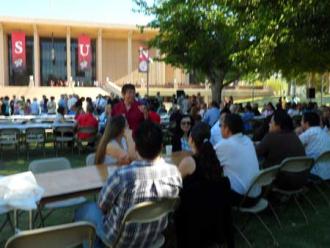
If there ever has been an experience for a university that speaks to the importance of planning, this past year is it!
If there was ever a demonstration of the importance of collaborative work that allows a university to improve itself, our recent experience is it.
If there is an exemplar for the positive consequences of civility and dialogue, the Cal State Northridge community is that exemplar.
The typical response of a university during the kind of economic recession we are in is to “hunker down.” But we chose to do things differently. We prepared for the storm and made strategic and structural changes that allowed us to not only weather this storm but be better prepared for the future. We entered the rough economic sea with a plan – five priorities – accompanied by fiscal restraint that made us more efficient and yielded monetary reserves to provide time and flexibility in responding to budget reductions. We restructured to be more efficient, not by making wholesale cuts, but strategically with an eye to upholding our deep values and commitment to our permanent employees. Decisions were made with laser-like focus on the five priorities – academic excellence, student engagement and success, resource enhancement, user-friendly business practices, and campus and community collaboration.
Now, as we look forward, we need, in fact we must, continue this journey with planning as our mantra. These tumultuous economic times have hastened and sharpened other challenges for universities – emerging realities discussed widely by those who speak and write about higher education. Our planning must take into account these emerging realities. Some of these we have considered previously; others are newly on our landscape. Planning does not mean that we will know what the specific outcome will be. Rather, planning for multiple futures will allow us to adjust as circumstances change.
The first is a challenge for which we must plan. I have addressed it previously – the changed financing of public higher education. For the past two decades, higher education has experienced a modest but continuous decline in state funding. Appropriations are reduced during recessions, with some restoration as the economy grows, but never quite to earlier levels. The pattern adds up to an incremental divestment of state funds. Thus we have seen growing dependency on student fees, budget cuts, and threats to access.(click here for endnote i) We know from our own budget numbers, from our experience day-to-day, that the decline in funding of public higher education is real. This is the new reality, and reversal is unforeseeable.
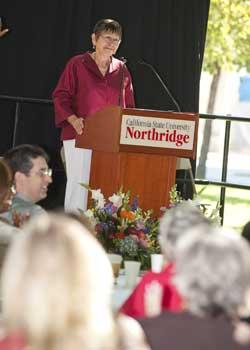 Under this new reality, it is imperative for higher education institutions to plan and to use resources strategically. As two well-known policy analysts, Dennis Jones and Jane Wellman, recently argued, public higher education will be unable to solve its funding challenges simply by looking for new revenues, turning to the Federal government, or cutting costs. And it is not useful to talk about what the budget “would have been” had cuts not occurred. Rather, Jones and Wellman urge us to focus on such policy agenda items as improving degree attainment, investing strategically in areas core to the educational mission, and improving teaching and learning productivity.
Under this new reality, it is imperative for higher education institutions to plan and to use resources strategically. As two well-known policy analysts, Dennis Jones and Jane Wellman, recently argued, public higher education will be unable to solve its funding challenges simply by looking for new revenues, turning to the Federal government, or cutting costs. And it is not useful to talk about what the budget “would have been” had cuts not occurred. Rather, Jones and Wellman urge us to focus on such policy agenda items as improving degree attainment, investing strategically in areas core to the educational mission, and improving teaching and learning productivity.
What this means for Cal State Northridge is we must simultaneously invest in areas central to our mission while also improving efficiency. The key for us, I think, is Jones’ and Wellman’s first admonition – improving degree attainment, or a focus on student retention and graduation. We have already embraced this goal.
A second linked challenge for public higher education is the imperative to educate more students but with less state funding. President Obama has called for expanded access to higher education, an imperative for the 21st century economy. Virtually every study about future workforce needs documents an increasing demand for college-educated workers and citizens. Daniel Hurley, AASCU’s Director of State Relations and Policy Analysis, argues that if public higher education is to meet this challenge, it must develop an orientation sharply directed toward understanding students, with the goal of improving teaching and student learning.(endnote ii) This has been our focus for some years now as a learning-centered university, but there is more work to be done.
Our third planning challenge is the public’s expectations about higher education – generally referred to as “accountability.” I have spoken often of the forces of accountability, so these words are not new. But please pay attention. When the U.S. Secretary of Education speaks repeatedly of the low graduation rates of public universities, we must pay attention. When the U.S. Undersecretary of Education argues for the need to marry college and work, and a major analysis of jobs data concludes the U.S. is headed toward a serious mismatch between the skills needed for new jobs and the education of potential workers, we must pay attention. When the chair of the National Governors Association says he will make higher education productivity the focus of his term, calling for common performance measurements and concrete steps to increase completion rates within available resources, we must pay attention.
A fourth planning challenge is the rapidity of change amidst ever-escalating advances in technology. Where higher education was traditionally about the transmission of knowledge through instruction, today technology enables student discovery as part of the learning equation. Where technology previously was instantiated through its ownership, it is now instantiated by access. Where technology was once primarily “on” the campus, it is now increasingly “above” (or away from) the campus. Where technology was once a utility, it is now a potential strategic advantage.(endnote iii)
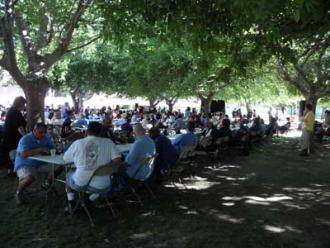 This brings me to a fifth major planning challenge. Alternative models of higher education have emerged, and students are increasingly choosing them. Some are smitten with the perceived cost-savings of education delivered via the Internet. But there is more to this development than just the money and convenience factors. We are on the cusp of a major shift in student demographics. Soon the incoming university class will be a cohort of “digital students” who, unless universities change, will struggle to find engagement in “analog schools.” They will likely demand education that embraces knowledge as something that is continuously created, not simply acquired and forever possessed. We will be pressed to commit to a new model of collaborative learning with our students. We already see these demands today, and we will need to embrace those adaptations that truly contribute to student success.
This brings me to a fifth major planning challenge. Alternative models of higher education have emerged, and students are increasingly choosing them. Some are smitten with the perceived cost-savings of education delivered via the Internet. But there is more to this development than just the money and convenience factors. We are on the cusp of a major shift in student demographics. Soon the incoming university class will be a cohort of “digital students” who, unless universities change, will struggle to find engagement in “analog schools.” They will likely demand education that embraces knowledge as something that is continuously created, not simply acquired and forever possessed. We will be pressed to commit to a new model of collaborative learning with our students. We already see these demands today, and we will need to embrace those adaptations that truly contribute to student success.
Additionally, students’ expectations are changing as for-profit universities offer, and extensively advertise, flexibility and convenience to match the realities of students’ lives. Degree options more immediately relevant to work and career resonate with students. Convenience of location and timing is achieved through technology and by stripping back to physical basics, eschewing co-curricular activities, athletics, extensive libraries, residence halls, and other features of the traditional campus. In many ways, this new model of higher education threatens the very definition of what we think of as a college or university, and yet many students are choosing it!
I see Cal State Northridge as a university well-positioned to continue to respond to these changes. Planning is necessary to move forward through this storm; we must chart a course that uses and builds on our strengths and sets an agenda for how we should and will respond to a rapidly and inexorably changing world.
We have been mindful and intentional in adjusting to new challenges, but we must, to reaffirm our commitment to tomorrow, now also become relentless in planning for them. We must set aside our hope that there will be another gold rush that would preserve our sense of entitlement to state dollars. We need to see the facts as they are, imagine practical alternatives without fixating on scapegoats, and accept that we must conserve resources. And, finally, we must neither wait for others to rescue us nor be surprised when our best ideas are frustrated, because in time, our efforts will prevail.
III. This year will see much work and additional planning that will allow us to reaffirm our commitment to tomorrow.
- First, and most important, we will continue to plan and implement our ongoing work to improve student success – retention and graduation. Resting on the laurels of our progress to date will not be sufficient. Funding and the very future of higher education will be linked by policymakers and our various publics to this metric of institutional success.
- We will also continue the work of restructuring basic administrative processes to be more efficient. All divisions have taken a five percent budget cut this year.
- Over the next year, Cal State Northridge will engage in collaborative planning to create a campus digital master plan called IT Vision@2015. Much as the Campus Master Plan has established a blueprint for the future of our physical campus; the digital master plan will establish a 5-year direction for information technology to support our mission and leverage expected technology developments.
- In January we will officially celebrate the opening of the Valley Performing Arts Center at California State University, Northridge, which is part of our plan to establish greater recognition for the University in the community and provide state-of-the-art instructional facilities for our faculty, staff, and students. Beyond the 1,700-seat main hall, the center will serve as an important academic space on campus, housing the Theatre Department, KSCN, and lecture, lab, practice, and office spaces. It will create opportunities for campus-community partnerships, most importantly K-12 education. I would like to thank Associate Vice President for Facilities Planning Colin Donahue and Construction Services Manager Ken Rosenthal for their work in the design and building, and Dean Bob Bucker and Assistant Provost Jerry Luedders, who have taken on roles of Executive and Associate Executive Director, for their leadership in the enormous effort of ramping up to this much-anticipated launch. I would also like to thank the many others in the campus community for their work to ensure we open a first-rate performance and academic venue.
- We have committed to developing a unified communications platform for the University, one that more fully and clearly articulates our uniqueness and distinctions. We know we are “good,” and it is time to unify our message and communicate to internal and external communities just what makes us good.
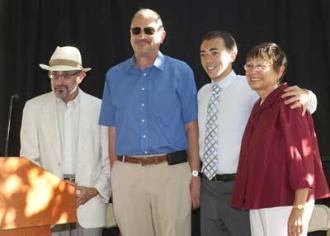
- Following the very affirming Capacity and Preparatory Review, we now enter the third and final phase of the WASC re-accreditation process, the Educational Effectiveness Review. We will prepare our report due next June, followed by a site visit next September. As we examine data and evidence around our effectiveness, we will continue to focus on student learning and engagement, responding to the imperative to be accountable to our publics. This University effort to achieve reaccreditation has been and will continue to be a model of collaborative, community-wide planning consistent with our University plan.
- Last year we commissioned a study of ways to reduce our environmental footprint. This year we will vet its findings and recommendations among academic and administrative units and develop a sustainable energy and facilities management plan.
- We continue to make improvements to the physical campus, for example, we will continue construction of the Student Recreation Center, designed to the LEED Gold Standard.
- Given all the challenges to higher education, the state and national economic circumstances, and sharp divides about social concerns, faculty members have organized a year-long campus-wide initiative on “Civil Discourse and Social Change.” We are honored and pleased to have Reverend James Lawson – a prominent civil rights leader and close associate of Martin Luther King – join us this academic year for a series of public lectures and other activities.
- We will continue to manage our enrollment. When allowed to grow, we will implement the strategic enrollment plan developed prior to the current budget crisis. For this year, we have more students than we planned. There is a possibility that the state budget will support additional enrollment for the CSU, but until a budget is approved with those dollars, we are attempting to respond to student needs here with additional course spaces and sections. Please help our students navigate this difficult environment. They are feeling enormous pressure, financial and otherwise, and while we might not be able to give them all they want, responding to them with courtesy and respect is important. I would like to take a moment now to thank Admissions and Records, the academic departments, and all of you who are responding to this swell in enrollment.
IV. Congratulations on a Year Well Done
Let me now congratulate the campus community on a year well done – a furloughed year well done. There is something in the Cal State Northridge DNA – a resiliency, a pragmatism, and confidence that “we can do it.” Through trying times, past and present, we have been mindful of our resources and remained focused on our mission, seeking improvements and learning to do our work better.
And so a few accomplishments from the past academic year.
- Early in the year we asked for your ideas to save money on campus. We have implemented many of your suggestions as well as other cost-saving measures. We use technology in new ways, and have eliminated much paper and postage usage. We transitioned students to Google’s gmail, a more cost effective email solution.
- We have found new ways to exercise environmental responsibility while saving money. PPM installed a Central Computerized Irrigation Control System, which calibrates just the right amount of irrigation, saving 56 million gallons of water annually. In partnership with The Boeing Company, we have 33 new high-concentration photovoltaic solar power panels.
Our mode is one of constant mindfulness about how to accomplish work efficiently while maintaining quality, and often improving it.
- The University’s teacher preparation programs received a glowing NCATE accreditation review, concluding there were no areas for improvements relevant to any standards. Other programs had similarly outstanding accreditation reviews, specifically Construction Management and Journalism.
- The Education Trust identified Cal State Northridge as a top “gap closer,” substantially improving graduation rates and closing graduation-rate gaps among traditionally under-represented groups.(endnote iv)
- Our faculty members, many working with students, produced a record number of grant proposals last year; and our numbers of faculty publications and presentations per faculty member exceeded that of our peer institutions.
- Our McNair, RISE and RIMI scholarship and grants activity establishes us as a pre-eminent master’s institution pathway to doctoral programs for traditionally underrepresented students.
- Two Cinema and Television Arts students received the American Society of Cinematographers Richard Moore Heritage Award honorable mention for outstanding achievement in student filmmaking, for their senior showcase film, “Sounds of Silence.”
- Both our Jazz “A” Band and student jazz combo were selected from among dozens of top college bands to perform at the prestigious Monterey Jazz Festival.
- Biology professor Steven Oppenheimer was among only 22 nationwide honored at the White House with the Presidential Award for Excellence in Science, Mathematics and Engineering Mentoring.
- A seven-member team of Construction Management Technology students took first-place in a nationwide, 40-school construction management competition.
- Our men’s volleyball team finished their season ranked third in the nation.
- Our women’s track and field, men’s track and field, softball and water polo teams won either regular season title or conference championships.
- Three head coaches were accorded Coach of the Year honors by the Big West Conference: Don Strametz, Men’s and Women’s Track and Field; Keith West, Women’s Soccer; and Terry Davila, Men’s Soccer.
- The U.S. Department of Education awarded California State University, Northridge more than $8.4 million in federal funding over five years to improve the education of teachers who work with students with disabilities.
- The Matador Bookstore’s textbook rental program expanded from just a few titles to over 1000 for Fall 2010, almost one-third of textbook adoptions.
- Newly installed lighting allows the return of nighttime soccer and expanded hours for North Field outdoor spaces used by Kinesiology and Associated Students. Our first soccer match in the cool of the evening is this Sunday.
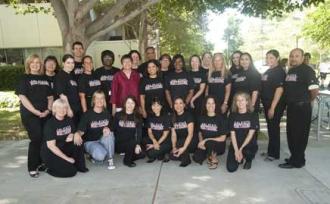
- The Student Health Center and the Children’s Center were awarded reaccreditation.
- The work of University Advancement garnered national recognition in receiving the Circle of Excellence Bronze Award from the Council for Advancement and Support of Education (CASE) for the University’s 2009 electronic holiday greeting, “The Gift.”
- The Staff Services Award and Excellence Recognition Event recognized the team who brought us the new Student myNorthridge Portal, a collaboration across the three divisions of Information Technology, Student Affairs, and Academic Affairs.Congratulations also to Leta Chow of Psychology, winner of the annual President’s Award.
- At the conclusion of the WASC re-accreditation Capacity and Preparatory Review last spring, the visiting team commended Cal State Northridge for vision, transparency and openness; short- and long-range planning embedded in the culture; shared knowledge and consultative decision-making; strong commitment to students and their success; a competent and energetic institutional research team; improvements in information technology and student advising; and strong work in assessing learning outcomes.
It doesn’t get any better than this praise!
Let’s hear it for our furloughed year of accomplishments at Cal State Northridge.
I close now with just a few words about dialogue and civility. As we look to the year and years ahead, I see many challenges, and yet I feel confident of this University’s future. That confidence is built on our already demonstrated capacity to carry out work, even very difficult work, with civility. The challenges facing public higher education – and Cal State Northridge in particular – can be met if we proceed in accord with our institutional commitment to maintaining dialogue with one another.
We in the Cal State Northridge community have done well in sustaining dialogue through uncertain and difficult times. University leaders – faculty, students, staff, and administrators – share a commitment to the highest standards of dialogue.
Recent articles in the Chronicle of Higher Education and similar publications refer to a perceived decline in collegiality in higher education. If that is indeed the rule, let us seek to be its exception.
I entreat you now, as we continue forward during this time of challenge and change, to work to nurture dialogue so that we may sustain our University community and the life-altering work we do. Let us reaffirm our commitment to this University’s tomorrow.
Endnotes
i) For a concise summary of these trends, see Dennis Jones and Jane Wellman, “Breaking Bad Habits: Navigating the Financial Crisis,” Change: The Magazine for Higher Education. May-June 2010.)
ii) Daniel J. Hurley, “Considerations for State Colleges and Universities in a Post-Recession America,” American Association of State Colleges and Universities, November 2009, [Available at. http://www.congressweb.com/aascu/hurley.htm]
iii) Presentation by Diana G. Oblinger, President and CEO of EDUCAUSE, “Leading the University of Tomorrow – Today,” Association of State Colleges and Universities Annual Meeting, November 2009. [Available at http://www.aascu.org/meetings/annual09/index.htm]
iv) Jennifer Engle and Christina Theokas, “Top Gap Closers: Some Public Four-Year Colleges and Universities Have Made Good Progress in Closing Graduation-Rate Gaps,” The Education Trust, January 2010.
